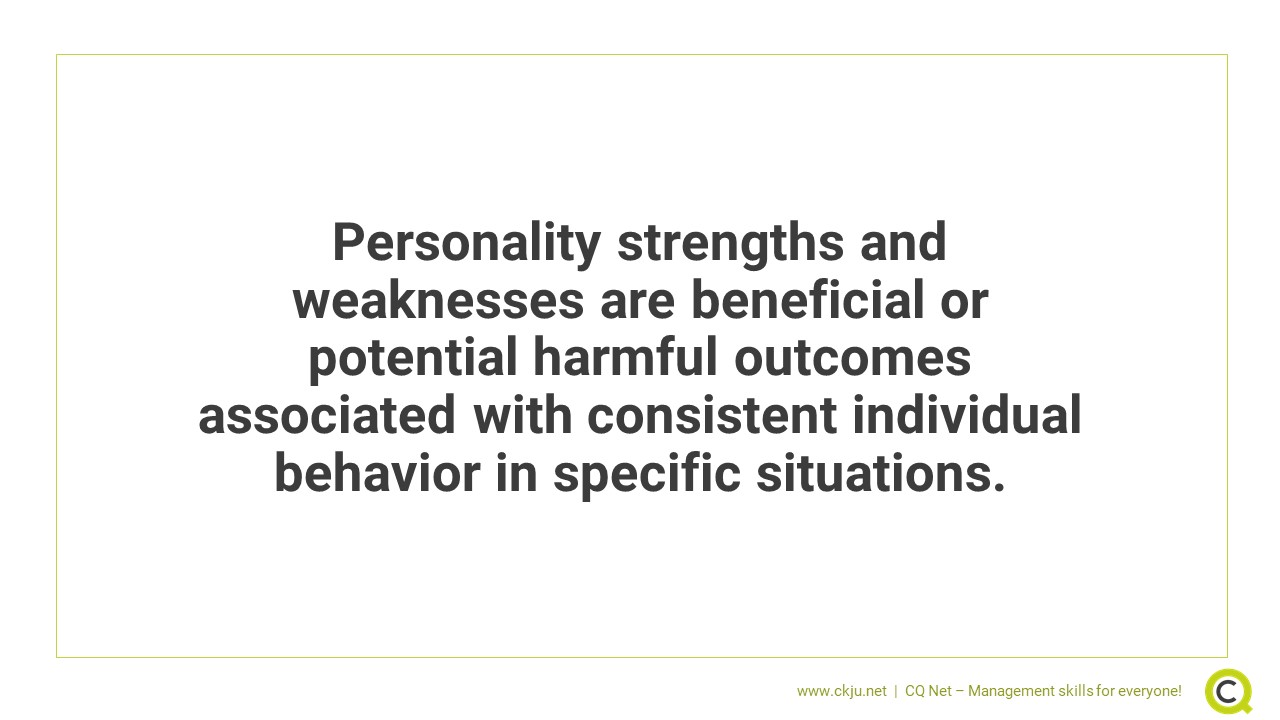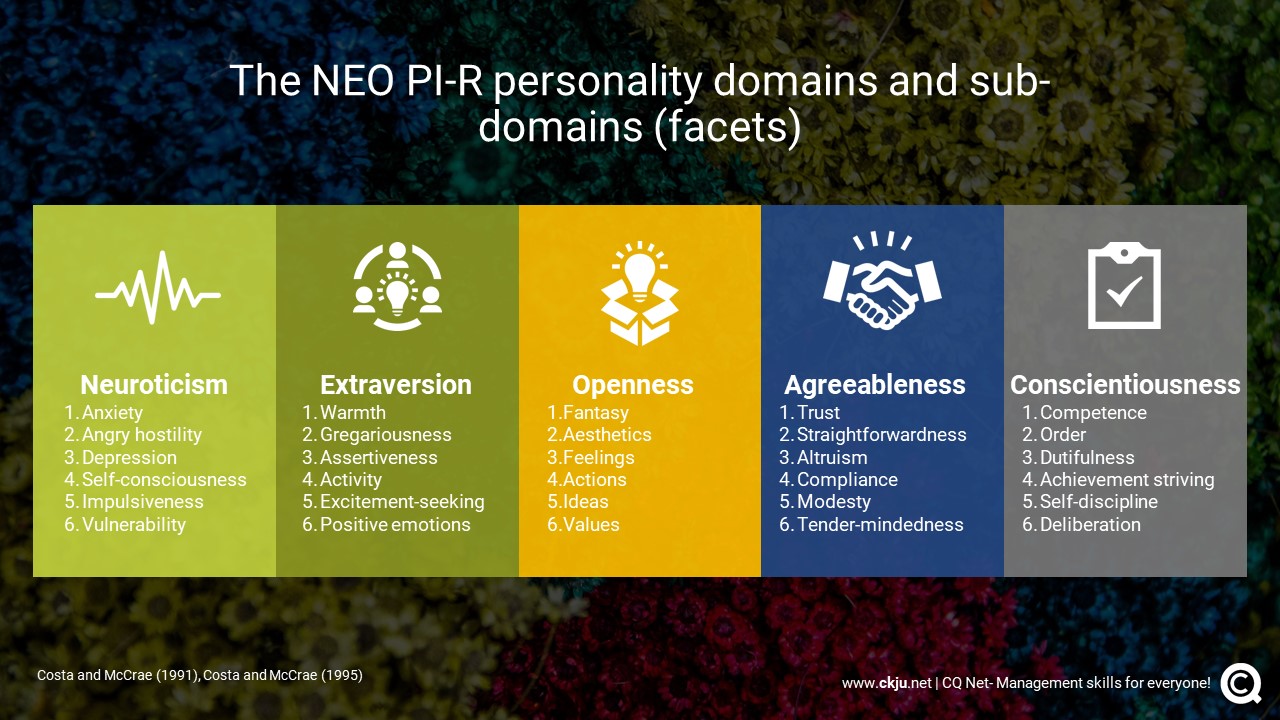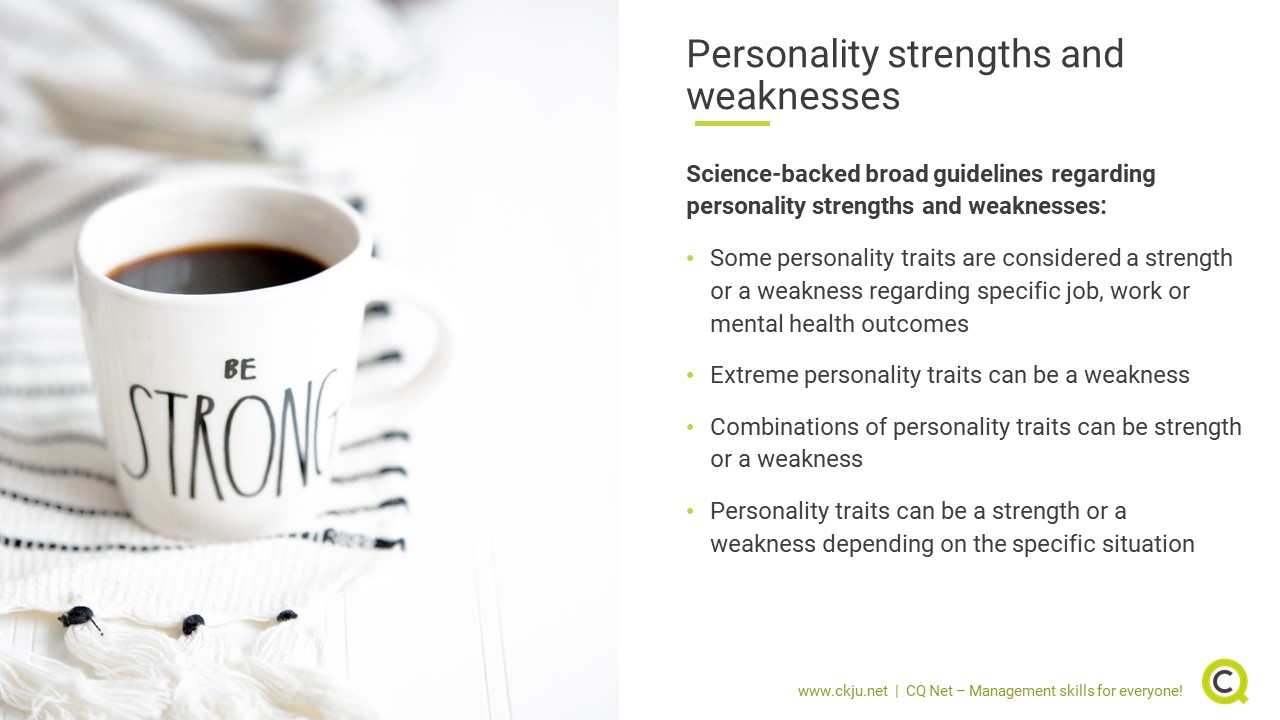- All Management Learning Resources
- Personality strengths and weaknesses

Why you should care about personality strengths and weaknesses?
There is a wealth of knowledge available about how your personality shapes your behavior at work and in your private life. On the one hand, this connection can be beneficial for some personality traits with a positive effect on performance and mental health. On the other hand, there are personality traits that are associated with negative effects such as depression and low performance. In this CQ Dossier we provide you the foundation of personality strengths and weaknesses, and how to identify and use them in practice as means for professional development.
Contents
- Why you should care about personality strengths and weaknesses?
- What are personality strengths and weaknesses?
- How do personality strengths and weaknesses work?
- The five factor model of personality
- Personality strengths and weakness based on five factor model of personality
- How to identify your personality strengths and weaknesses?
- Key recommendations for professionals
- References and further reading
What are personality strengths and weaknesses?
Knowing your strengths and weakness matters both for your private and professional life. This especially applies to personality, as it allows you to better understand potential weak and strong points in your behavior in different situations. Starting from there, we can define personality strengths and weaknesses as follows:
Personality strengths and weaknesses are beneficial or potential harmful outcomes associated with consistent individual behavior in specific situations.
Broadly speaking, personality is an individual uniqueness that characterizes the way people behave in different situations. Behavior is usually associated with some sort of outcome. Depending on whether the situation is work- or family-related, the specific behavior has a positive or negative impact on
- job, team or organizational performance,
- life outcomes such as mortality, divorce, and
- mental health.
Until recently, it was generally accepted that one’s personality stays more or less stable over a lifespan. Recent insights support the claim that personality traits are much more dynamic than initially thought (Caspi et al., 2005). This makes it especially appealing to use the concept of personality strengths and weaknesses for professional development activities.
How do personality strengths and weaknesses work?
There are hundreds of personality models and tests available that promise to describe and measure personality traits. Some of them are even available for free. Even though it is appealing to use one of those personality tests, please be aware that almost all of them do more harm than good as they are of questionable quality and serve no particular end.
In order to make a deep dive into personality strengths and weaknesses, we will draw on the The Five Factor Model of personality (also called Big 5) (Costa and McCrae, 1992; Costa and McCrae, 1995). The Big 5 model and the associated NEO-PI personality test meet all required quality criteria and are well established and researched management tools.
The five factor model of personality
The five factor model of personality distinguishes the following five broad personality traits also called OCEAN:
- openness (O),
- conscientiousness (C),
- extraversion (E),
- agreeableness (A), and
- neurotisicm (N).
Furthermore, the NEO-PI personality test (Costa and McCrae, 2008) has the advantage of measuring personality traits on a continuum in relation to a norm group. It also breaks down each of the five personality domains into six subdomains (Costa and McCrae, 1995). This makes the NEO-PI the personality test of choice to talk about personality strengths and weaknesses.
Personality strengths and weakness based on five factor model of personality
Whether a specific personality trait is a strength or weakness strongly depends on the specific personality trait combination, situation, and context. Consequently, knowing your individual personality strengths and weakness requires you to take the NEO-PI and to discuss the results - for example with one of our management counselors.
However, there are some science-backed broad guidelines regarding personality strengths and weakness you should be aware of. We will briefly review and discuss them.
Personality traits considered as strength
Some of the five factor model personality traits are directly linked to positive outcomes. For instance, conscientiousness is a modest predictor of job performance (Hurtz and Donovan, 2000). This is straightforward, considering that achievement striving, self-discipline and dutifulness are sob-domains of consciousness.
Interestingly, some studies also found that conscientiousness has a positive impact on life outcomes such as mortality and occupational status (Roberts et al., 2007).
In terms of career satisfaction, conscientiousness, extraversion and openness have a positive effect according to Lounsbury et al. (2003).
Judge, Heller et al. (2002) conducted a study regarding the relationship of the big five personality traits and job satisfaction. They found that extraversion and conscientiousness is positively related to job satisfaction.
While some personality traits are clearly associated with positive outcomes, there is a limit to this positive effect. Too much of a good thing can lead to negative side-effects as we will explore next.
Extreme personality traits can be a weakness
Broadly speaking, extreme personality traits can be a weakness. Extreme refers in this context to a very low or high score in one of the big five personality domains compared to the norm group.
For instance, people who score high in neuroticism experience negative emotions more frequently than people who are low in this personality trait. A very high level in neuroticism is usually associated with a lower stress tolerance and a higher likelihood of depressive mood (Barlow et al., 2014).
There is also risk that extreme personality traits can become destructive. For instance, Paulhus and Williams (2002) found a connection between a low level of agreeableness and the so-called dark triad. The dark triad refers to the negative and potentially destructive personality traits narcissism, Machiavellianism and psychopathy.
Interestingly, conscientiousness - which is a modest predictor of job performance - can also do more harm than good at very high levels. Le et al. (2011) found that people very high in conscientiousness receive less favorable job performance ratings.
The same applies to people with a very high level of emotional stability (Le et al., 2011).
When conscientiousness becomes rigidity and emotional stability becomes detachment, personality traits that are usually seen as strength start to backfire.
Too much of a good thing can become a liability rather than a strength. This also applies to personality traits.
Combinations of personality traits can be a strength or a weakness
In real life situations, it is rarely one personality trait that makes a difference. This makes it important to look at how different personality traits can create synergies or disharmony when working together.
For instance, a healthy combination of the personality traits extraversion, conscientiousness, openness, agreeableness, and a low level of neuroticism can be beneficial when working in teams. Especially the two personality traits extraversion and agreeableness have a strong social component as reflected in their NEO-PI subdomains of gregariousness and altruism (Costa and McCrae, 1995).
In terms of leadership, Judge, Bono et al. (2002) found that extraversion and conscientiousness is positively related to leadership effectiveness while neuroticism has a negative impact. Since more and more organizations rely on shared leadership approaches (Kukenberger and D'Innocenzo, 2020), leadership qualities start to become more important for professionals without formal leadership responsibility.
While there are some indications available which personality traits go well together, it is dangerous to generalize those findings. For instance, people who score high in the personality traits extraversion, conscientiousness and openness could face the risk of overwhelming others in situations that require thoughtful and carefully planned management interventions.
Personality traits can be a strength or a weakness depending on the situation
On a detailed level, every situation is unique. As a result, when talking about personality strengths and weaknesses it is important to consider the interplay between personality traits and situation.
For instance, in a situation that requires fast and straightforward decisions, scoring high in the personality traits extraversion, agreeableness and openness can we a weakness. It doesn't add value to start discussion about how to proceed when the decision in inevitable.
On the contrary, a newly created team with a low level of team cohesion might feel overwhelmed by a team member that scores high in extraversion and low in agreeableness.
How to identify your personality strengths and weaknesses?
The easiest way to get to know your personality strengths and weaknesses is to follow the following four step approach:
- Select the right management counselor
- Take a high-quality personality test such as the NEO-PI
- Discuss the results with your management counselor
- Learn how to foster your personality strengths and work on your weaknesses
We have put together a comprehensive guideline about how to select and take a personality test. You can also drop us a message and one of our management counselors will get back to you and discuss how you get most out of a personality test.
Key recommendations for professionals
- Personality strengths and weaknesses do have an impact on performance, life outcomes and mental health
- Knowing your personality strength and weaknesses is an important starting point for professional development
- The five factor model of personality which is the basis for the NEO-PI personality test is a great tool to understand your personality
- There are some science-backed broad guidelines regarding personality strengths and weaknesses available you should be aware of
- Involve an experienced management counselor to identity your personality strengths and weaknesses and work on them
References and further reading
Barlow, D. H., Sauer-Zavala, S., Carl, J. R., Bullis, J. R. and Ellard, K. K. (2014) ‘The Nature, Diagnosis, and Treatment of Neuroticism’, Clinical Psychological Science, vol. 2, no. 3, pp. 344–365.
BARRICK, M. R. and MOUNT, M. K. (1991) ‘THE BIG FIVE PERSONALITY DIMENSIONS AND JOB PERFORMANCE: A META-ANALYSIS’, Personnel Psychology, vol. 44, no. 1, pp. 1–26.
Caspi, A., Roberts, B. W. and Shiner, R. L. (2005) ‘Personality development: stability and change’, Annual review of psychology, vol. 56, pp. 453–484.
Costa, P. T. and McCrae, R. R. (1992) ‘Normal personality assessment in clinical practice: The NEO Personality Inventory’, Psychological Assessment, vol. 4, no. 1, pp. 5–13.
Costa, P. T. and McCrae, R. R. (1995) ‘Domains and facets: hierarchical personality assessment using the revised NEO personality inventory’, Journal of personality assessment, vol. 64, no. 1, pp. 21–50.
Costa, P. T. and McCrae, R. R. (2008) ‘The Revised NEO Personality Inventory (NEO-PI-R)’, in The SAGE Handbook of Personality Theory and Assessment: Volume 2 — Personality Measurement and Testing, 1 Oliver's Yard, 55 City Road, London EC1Y 1SP United Kingdom, SAGE Publications Ltd, pp. 179–198.
Hurtz, G. M. and Donovan, J. J. (2000) ‘Personality and job performance: the Big Five revisited’, The Journal of applied psychology, vol. 85, no. 6, pp. 869–879.
Judge, T. A., Bono, J. E., Ilies, R. and Gerhardt, M. W. (2002) ‘Personality and leadership: a qualitative and quantitative review’, The Journal of applied psychology, vol. 87, no. 4, pp. 765–780.
Judge, T. A., Heller, D. and MOUNT, M. K. (2002) ‘Five-factor model of personality and job satisfaction: a meta-analysis’, The Journal of applied psychology, vol. 87, no. 3, pp. 530–541.
Kukenberger, M. R. and D'Innocenzo, L. (2020) ‘The building blocks of shared leadership: The interactive effects of diversity types, team climate, and time’, Personnel Psychology, vol. 73, no. 1, pp. 125–150.
Le, H., Oh, I.-S., Robbins, S. B., Ilies, R., Holland, E. and Westrick, P. (2011) ‘Too much of a good thing: curvilinear relationships between personality traits and job performance’, The Journal of applied psychology, vol. 96, no. 1, pp. 113–133.
Lounsbury, J. W., Loveland, J. M., Sundstrom, E. D., Gibson, L. W., Drost, A. W. and Hamrick, F. L. (2003) ‘An Investigation of Personality Traits in Relation to Career Satisfaction’, Journal of Career Assessment, vol. 11, no. 3, pp. 287–307.
Paulhus, D. L. and Williams, K. M. (2002) ‘The Dark Triad of personality: Narcissism, Machiavellianism, and psychopathy’, Journal of Research in Personality, vol. 36, no. 6, pp. 556–563.
Roberts, B. W., Kuncel, N. R., Shiner, R., Caspi, A. and Goldberg, L. R. (2007) ‘The Power of Personality: The Comparative Validity of Personality Traits, Socioeconomic Status, and Cognitive Ability for Predicting Important Life Outcomes’, Perspectives on psychological science : a journal of the Association for Psychological Science, vol. 2, no. 4, pp. 313–345.
About the Author

Related Dossiers









